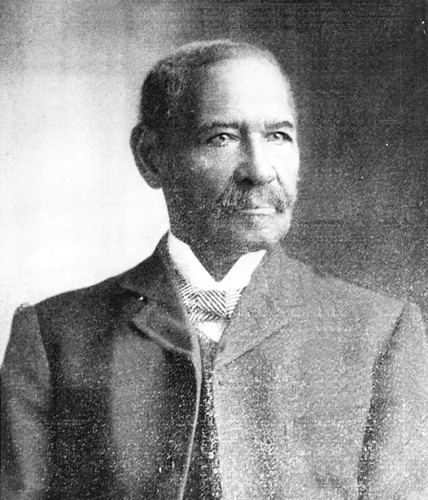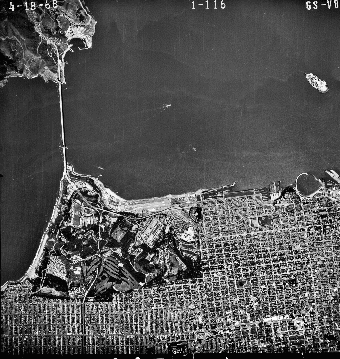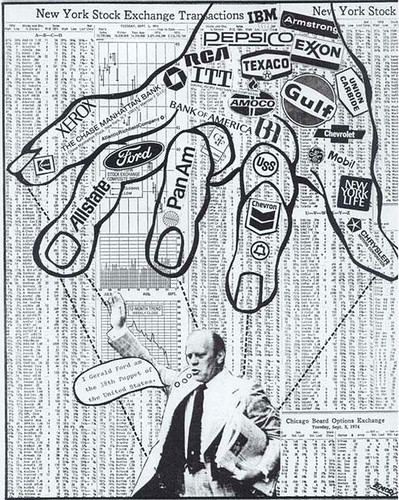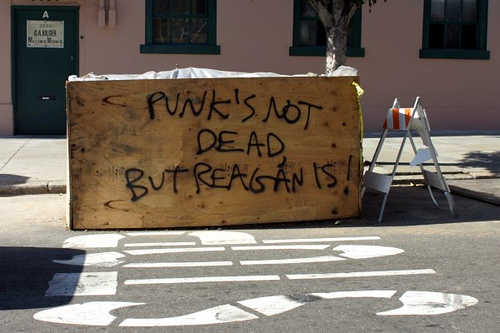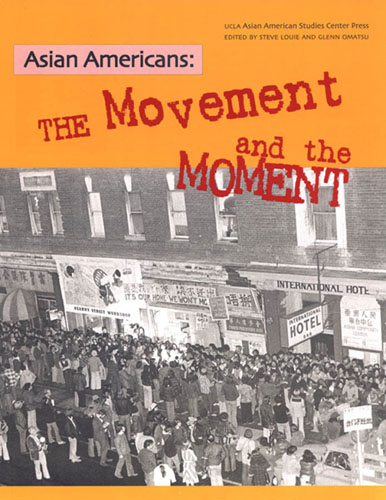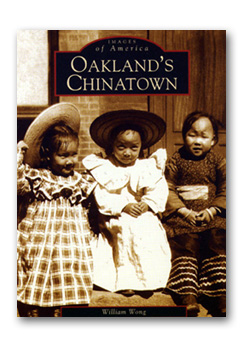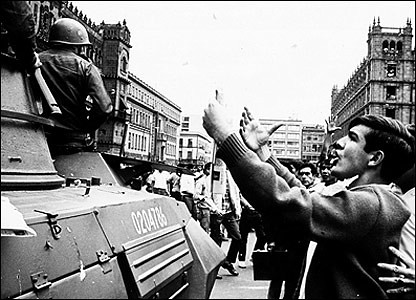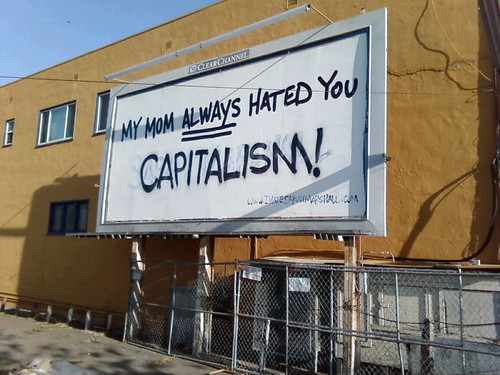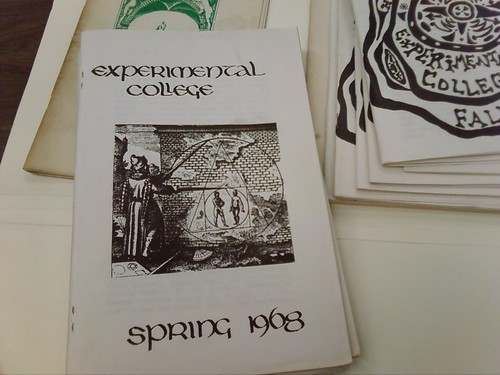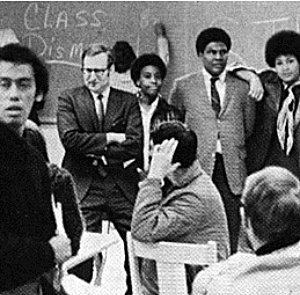
San Francisco State lacks ivy and graying brick and doddering old Englishmen riding their bicycles to class or whatever it is that makes for a prestigious university. It is a working-class college by design and students are as likely to show up on the streetcar as they are to live on campus, just like in the 1960s. Its public school nature might explain why the student activism that was almost ubiquitous on campuses in the mid-1960s looked different at State than it did at schools filled with the children of the ruling class. Maybe the Sixties activism at State had a more lasting impact too. While college students around the country helped stop the Vietnam war, the current mire in Iraq leaves that victory a little hollow. But the demonstrations at State led to the formation of the country's first ethnic studies department – an institution that quickly spread to campuses around the country and is still a major feature of universities around the world. The classic Sixties student concerns were at State too. Anti-war students held marches and sit-ins at State. But anti-war protests were only a part of the picture.
State had innovated the general education requirement that students at most colleges now expect (or dread), but by 1965, State students were criticizing these general classes as irrelevant. They founded their own Experimental College – student-run seminars on topics like social change, avant-garde art and personal growth. After Steven Gaskin's Monday night class on mysticism, spirituality and etcetera outgrew its home at the Experimental College he brought his dozens of followers in a caravan of school buses to Tennessee where they founded the archetypical counterculture commune -
The Farm. The trippy Experimental College people opened up thinking about what a college could be. They made student directed education a reality, which probably influenced the focus of the third and most lasting thread in State's student movement.
That third thread was the increasing militancy among black, Latino, Asian-American, and indigenous student activists. Radical students of color, many who were involved in off-campus movement work, wanted curriculum that mattered
to them. They wanted the college to offer something beyond the white, Western histories, art, music, and perspectives that dominated academics at the time. They wanted teachers who came from their own communities and meaningful access to education for the people of color who were not getting admission to the school in the first place. Students of color wanted a say in the programs that impacted them, and as such, a formerly white-run community tutoring program where mostly white State students worked with mostly black children in the Fillmore was one of the first campus organizations to have a total personnel and color changeover. Black tutors rejected the apparent paternalism of the liberal white tutors and stepped in to teach black kids themselves. On campus, students and progressive instructors pushed for Black Studies classes and got them, but only with part-time professors. Student leaders pushed for a recognized Black Studies department with full time black professors. They argued for broader admissions policies to allow poor black and brown kids access to the school.
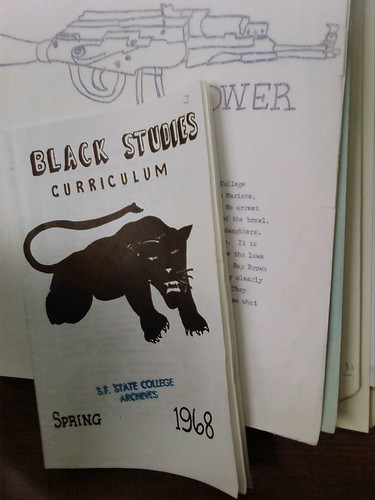
Mainstream white students started getting nervous. The campus newspaper,
The Gater, printed a notice from their white editor stating that he had written to the Carnegie Corporation asking them to reverse their plans to fund off campus State programs including programs of the Black Student Union. This was 1967. Non-violent civil rights groups seemed irrelevant to a lot of young, black activists in San Francisco who were more likely to find inspiration from Malcolm X than Martin Luther King. The larger protest movement was taking on a militant flavor too. In this context, a few irate black students responded to the
Gator editorial by beating the editor in question.
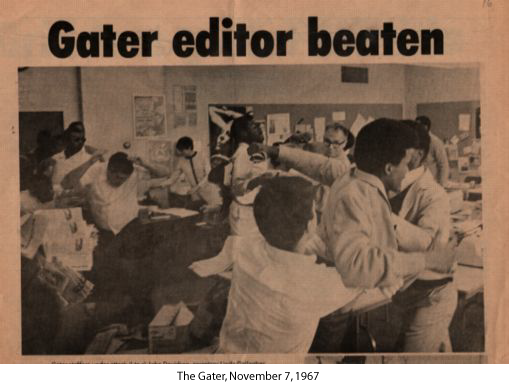 From the SF State Library Strike Collection
From the SF State Library Strike Collection The students involved in the beating were suspended, supporters demonstrated in their defense, campus organizing grew. Part of what made the SF State struggle special was that students resisted a dichotomous view of race as simply black and white. Filipino and Chicano students were as influential as Black students in forming the radical agendas of the moment. PACE, San Francisco State's Pilipino American student group may have been the first radical Filipino American organization in the country. PACE, the Latin American Students Organization, El Renacimiento, a Mexican American student organization and other ethnic-based student groups united under the banner of the Third World Liberation Front. Radical white students supported Third World students with their own demonstrations opposing the war and supporting the call for racial fairness and Ethnic Studies programming. By 1968 students around the country (and in Mexico, Germany, France, Japan, and elsewhere) were seizing university buildings in protest or for their own purposes. In March of 1968 the Third World Liberation Front took over the YMCA office at State.
The administration cracked down. Not just on students but also on their progressive teachers. Professor and activist Juan Martinez had been hired by the history department and also to direct a new program aimed at bringing more "minority" students to the campus. When in the spring of 1968 he helped bring several hundred Mexican and Pilipino American students to demand applications from the Dean of Admissions, he was told that he would not be re-hired in the fall. George Murray, a minister of education with the Black Panther Party, was hired to teach general ed English classes, but when he told an audience at Fresno State that, "we are slaves and the only way to become free is to kill all the slave masters", he was suspended. George Murray's suspension triggered a breaking point for student activists, and in November of 1968 students walked out of classes. Led by Black and Third World students and supported by the radical and mostly white Students for a Democratic Society, they created two lists of their strike terms (one from the Black Student Union and one from the Third World Liberation Front) that included the demand to re-hire George Murray, automatic admission for all Third World Students who applied to the school, and a creation of permanent Black Studies and Ethnic Studies departments with paid, full-time staff.
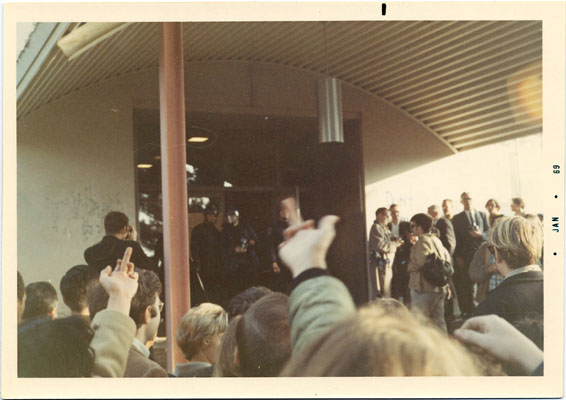 From the San Francisco History Center
From the San Francisco History Center The administration panicked. The police were called in, in large numbers and clad in riot helmets. A series of college presidents resigned before S. I. Hayakawa, the Canadian-born Japanese-American professor was promoted to the position. (Hayakawa initially made a name for himself in Semantics and he wrote an important
book which he hoped would serve as a critique of fascist propaganda. Apparently critiquing fascism lost its appeal – after State he served as a Republican in the US Senate and in the early '80s he founded
US English, an English-only advocacy organization. I should also mention that for most of his career he was known for wearing a jaunty Tam-o-Shanter.)
 From the San Francisco History Center
From the San Francisco History CenterHayakawa's first official act as president was shutting down the campus. If students insisted on walking out of class, then school would be closed to avoid the massive demonstrations. When school officially re-opened in early December (with sparse student attendance), Hayakawa confronted demonstrators who were broadcasting pro-strike messages from a soundtruck on the corner of 19th and Holloway. As the argument escalated the college president climbed on top of the protestors' truck to rip the wires out of its speakers. In return, someone pulled his tam off his head. In the hubbub Hayakawa apparently yelled ''You're fired!'' at author and State professor
Kay Boyle, and she apparently replied by calling him 'Hayakawa Eichmann". The strike went on.
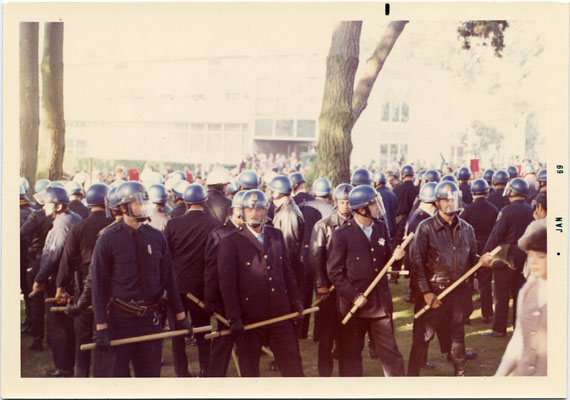 From the San Francisco History Center
From the San Francisco History Center By early January of 1969, Hayakawa had banned all gatherings on the central campus and limited access for non-students. Picketers were required to remain on the perimeters of the property. But at this point the situation was uncontainable. The SF State local of the California Teachers Federation joined the strike demanding educational reform, removal of police from the campus, agreement to student demands, and a collective bargaining contract. When the San Francisco Superior Court ordered the teachers back to work the next day they refused.
Strike related protests happened frequently and on and off campus. Sympathetic City College of San Francisco students marched to State to express their solidarity. State students and supporters marched to City Hall. Across the bridge students at Oakland City College (now called Merritt) protested in support of the struggle. In January of 1969 Third World students at U.C. Berkeley started
their own, related strike for Black and Ethnic Studies departments. Movements for Black and Ethnic Studies were growing at campuses in
New York,
New Jersey,
Washington,
Wisconsin,
North Carolina, all over.
The strike went on. Lines of police occupied the campus all day like a military force. One freshman was injured when his homemade bomb blew up in his hands. Professional negotiators were called in. San Francisco's Mayor Alioto appointed a citizens committee to negotiate the strike. And finally in March, the Third World Liberation Front, the Black Students Union, and university administrators (not including Hayakawa) signed a compromise agreement: An ethnic studies department was established. The university pledged to admit hundreds of new black and third world students. In short, we won. We won at State and like dominos, universities around the country dropped their resistance to Ethnic Studies programs, hired more teachers of color, admitted more black and third world students. Community control seems a pretty abstract idea now, but classes and teachers that reflect our real experiences and lives are the lasting gift that San Francisco State strikers left us when they took control of their own education and their own institution. So thank you.
For more on the San Francisco State Strike:
PACE has a little youtube video about their history:
And here's a short documentary on the strike from SGTV:
State has a great archive of the strike. Some of it is online here. Check out their list of books on the strike too.
For a little first person story related to the strike check out Its About Time, a Black Panther Party commemorative website for an account of the related San Francisco Community College strike. Don’t miss the PDFed news articles from the time, linked at the bottom of the article.
Shaping San Francisco has another account, and another.
Finally, if you can stomach some annoying Marxist voiceover for the sake of some fantastic footage, California Newsreel's San Francisco State: On Strike is worth a watch. It includes some pretty ugly police brutality that I hadn't thought to anticipate when I watched it with my five year old.
